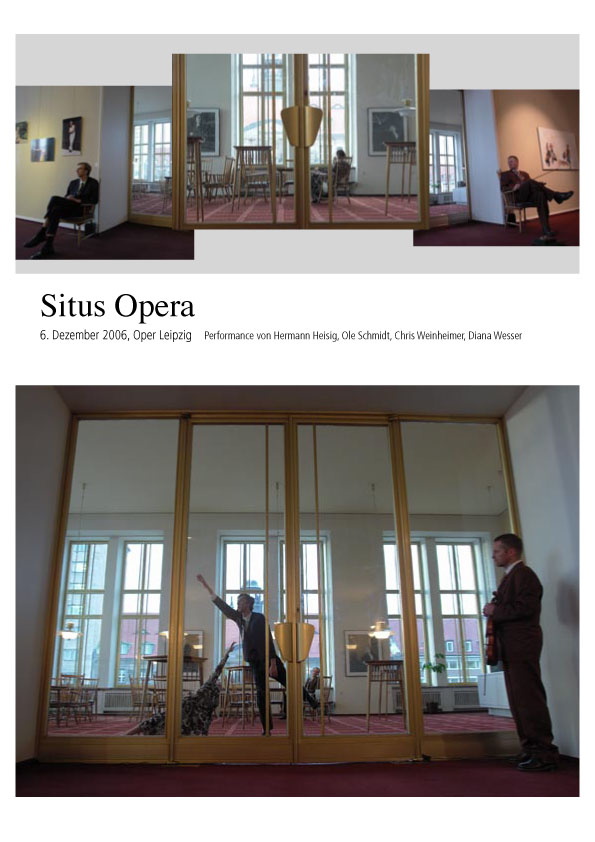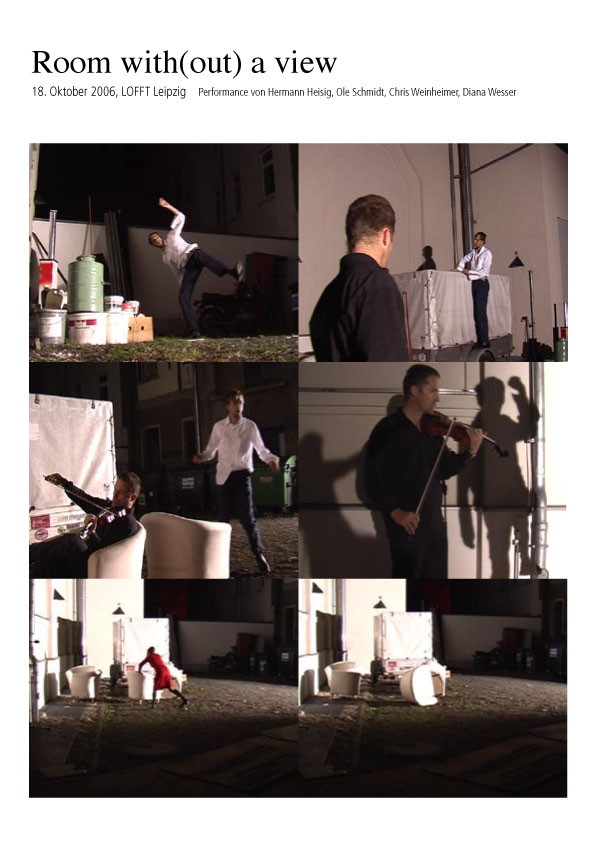flexible response ))))|
Performativ Systems
Hermann Heisig (performance)
Ole Schmidt (sounddesign, clarinet, performance)
Chris Weinheimer (violin, performance)
Diana Wesser (performance, video)

situs opera
investigates the acoustic and visual memory of the opera, its theatrical codes, gestures and patterns of movements of both stage and audience. One a lounges was transformed into a stage. A space for self-dramatisation, where the boundaries between acting and real life are fluent. The big glass doors were closed creating a typical picture stage. The performance moved between the inside and the outside of a lounge.
Microphones transmitted the sounds within to the audience sat outside. Modified opera music at an accelerated tempo, slowed down arias from the early 19th Century, live-improvisation and singing mapped the acoustic memory of the building. The performers worked with the gestures of the singers and the audience in a comparable way: repetition, modified speed, exaggeration and diminution of the movements reproduced the visual echos. These performative elements were used to create a 40 minute performance starting and ending with the same image: a theatrical extract of the opera.

room with(out) a view
("space copy chronology"#8 of the series "Systemkritik/Materialausgabe")
Room with(out) a view worked with the specifics of the LOFFT's theatre room. Alongside the room a closed courtyard is located. Both spaces are connected by one door. To begin the theater room was dark and filled with urban sounds. The performance started outside and was transmitted into the theatre space by video projection and microphones.
Two dancers and a musician investigated the courtyard's impulses for a performance. Different materials produced various sounds, objects were inspected and movements tried out. The performer's shadows were also protagonists, culminating in the production of an eldritch atmosphere intensified by the modified sound.
One after the other the performers entered the stage. They operated with the video image of their college, in real time, but spatially separated. The video tape was rewound and played back after about 40 minutes. Ultimately all the performers were on stage performing with their projected images. The duration was defined by the videotape. The image of the empty courtyard marked the end of the performances. Finally the theatre space was dark again and the urban sounds faded away.

Variations V von John Cage
in the rear of the unknown
The score of Cage's "Variations V" consists of "Thirty-seven remarks re an audio-visual performance". These notes describe a multi-media-system, consisting of shortwave receivers, tape machines, amplifiers, mixing consoles, oscillators, photoelectric barriers, film and tv sets. Further, the remarks define something like a goal ore a sense of the score: "‘Breakthrough’ by means of collaboration into the ‘unorganized areas in the rear’ of the unknown" or "Do sounds flow through the system? If not, make changes so that they do". The system itself was a closed circuit structured by the dancers' movements. This remarks were interpreted under our own aesthetic premises. Diana Wesser's films "Dancing about architecture" and a live-camera were used to feed the visual part, sounds "in the air" and of the oscillators connected to the photoelectric barriers plus instrumental interventions fed the acoustic part of the system. During the Performance this system was explored by the involved artists.